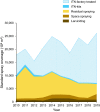Recent trends in global insecticide use for disease vector control and potential implications for resistance management
- PMID: 34903838
- PMCID: PMC8669011
- DOI: 10.1038/s41598-021-03367-9
Recent trends in global insecticide use for disease vector control and potential implications for resistance management
Abstract
Insecticides have played a major role in the prevention, control, and elimination of vector-borne diseases, but insecticide resistance threatens the efficacy of available vector control tools. A global survey was conducted to investigate vector control insecticide use from 2010 to 2019. Out of 140 countries selected as sample for the study, 87 countries responded. Also, data on ex-factory deliveries of insecticide-treated nets (ITNs) were analyzed. Insecticide operational use was highest for control of malaria, followed by dengue, leishmaniasis and Chagas disease. Vector control relied on few insecticide classes with pyrethroids the most used overall. Results indicated that IRS programs have been slow to react to detection of pyrethroid resistance, while proactive resistance management using insecticides with unrelated modes of action was generally weak. The intensive use of recently introduced insecticide products raised concern about product stewardship regarding the preservation of insecticide susceptibility in vector populations. Resistance management was weakest for control of dengue, leishmaniasis or Chagas disease. Therefore, it will be vital that vector control programs coordinate on insecticide procurement, planning, implementation, resistance monitoring, and capacity building. Moreover, increased consideration should be given to alternative vector control tools that prevent the development of insecticide resistance.
© 2021. The Author(s).
Conflict of interest statement
The authors declare no competing interests.
Figures




References
-
- Kyu HH, et al. Global, regional, and national disability-adjusted life-years (DALYs) for 359 diseases and injuries and healthy life expectancy (HALE) for 195 countries and territories, 1990–2017: A systematic analysis for the Global Burden of Disease Study 2017. Lancet. 2018;392:1859–1922. - PMC - PubMed
-
- WHO . World Malaria Report 2020. World Health Organization; 2020.
Publication types
MeSH terms
Substances
Grants and funding
LinkOut - more resources
Full Text Sources

